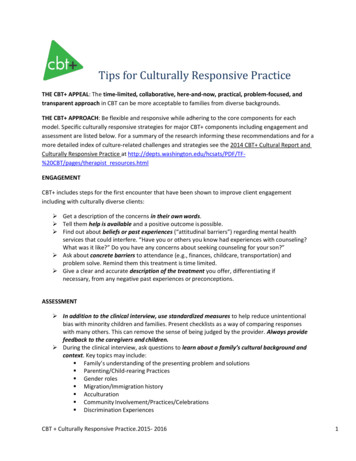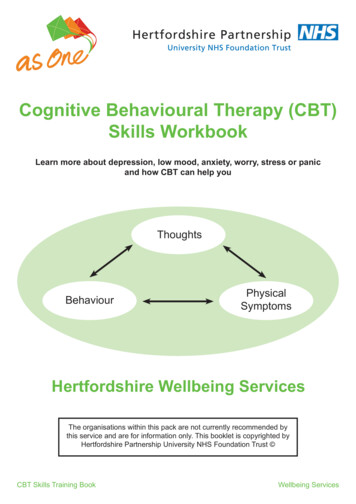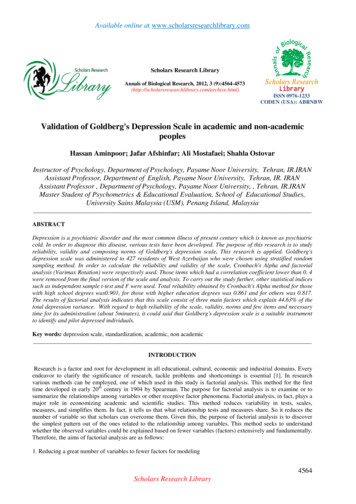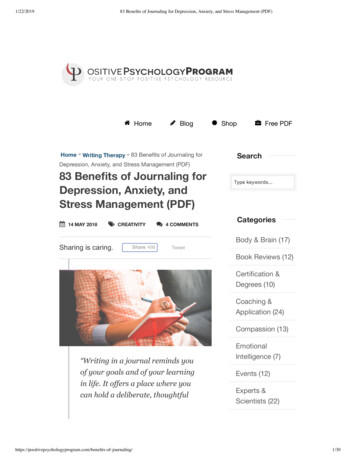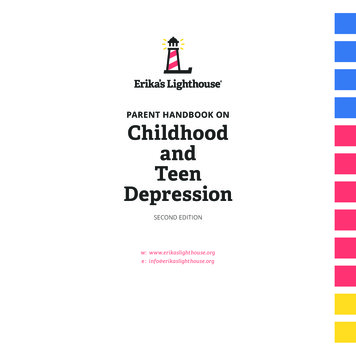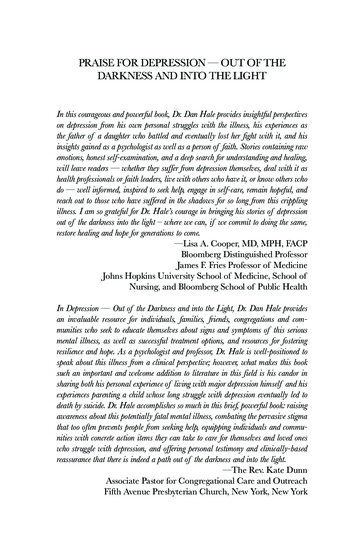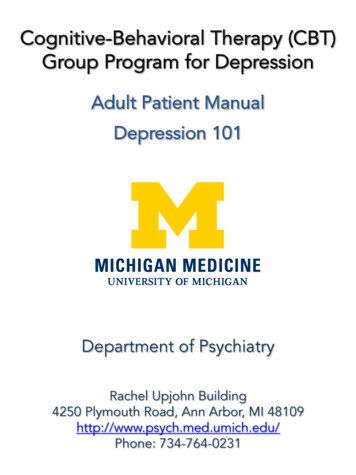
Transcription
Cognitive-Behavioral Therapy (CBT)Group Program for DepressionAdult Patient ManualDepression 101Department of PsychiatryRachel Upjohn Building4250 Plymouth Road, Ann Arbor, MI 48109http://www.psych.med.umich.edu/Phone: 734-764-0231
AcknowledgementsCognitive-Behavioral Therapy (CBT)Group Program for DepressionPatient ManualWritten and Edited by:Dan DeSena, LMSW, DMASara Tischler, LMSWKristen Miner, LMSWJessica Rimer, LMSW
AcknowledgementsCognitive-Behavioral Therapy (CBT) Group Program for Depression Patient ManualParts of this manual were broadly adapted and integrated from the following sources aboutdepression, Cognitive-Behavioral Therapy, and group psychotherapy:Addis, M.E. & Martell, C.R. (2004). Overcoming depression one step at a time: The new behavioral activation treatmentto getting your life back. Oakland, CA: New Harbinger.Beck, A.T., Rush, B.F. & Emery, G. (1979). Cognitive therapy of depression. New York: Guilford Press.Beck, J.S. (2011). Cognitive therapy: Basics and beyond, (2nd ed.). New York: Guilford Press.Burlingame, G.M., MacKenzie, K.R. & Strauss, B. (2004). Small-group treatment: Evidence for effectiveness andmechanisms of change. In M.J. Lambert, A.E. Bergin, & S.L. Garfield (Eds.), Bergin and Garfield’s handbook ofpsychotherapy and behavior change (5th ed., pp. 647-696). New York: Wiley.Burlingame, G.M., Fuhriman, A., & Johnson, J.E. (2002). Cohesion in group psychotherapy. In J.C. Norcross (Ed.),Psychotherapy relationships that work: Therapist contributions and responsiveness to patients (pp. 71-87). New York:Oxford University Press.Dimidjian, S., Hollon, S.D., Dobson, K.S., Schmaling, K.B., Kohlenberg, R.J., Addis, M.E., et al. (2006). Randomized trialof behavioral activation, cognitive therapy, and antidepressant medication in the acute treatment of adults with majordepression. Journal of Consulting and Clinical Psychology, 74(4), 658-670.Germer, C.K. & Neff, K.D. (2013). Self-compassion in clinical practice. Journal of Clinical Psychology: In Session, 69(8),856–867.Hayes, S.C., Strosahl, K.D. & Wilson, K.G. (2012). Acceptance and commitment therapy: The process of mindfulchange. New York: The Guilford Press.Jacobson, N.S., Martell, C.R., & Dimidjian, S. (2001). Behavioral activation treatment for depression: Returning tocontextual roots. Clinical Psychology: Science and Practice, 8(3), 255-270.Lejuez, C.W., Hopko, D.R., LePage, J., Hopko, S.D. & McNeil, D.W. (2001). A brief behavioral activation treatment fordepression. Cognitive and Behavioral Practice, 8, 164-175.Martell, C.R., Dimidjian, S. & Herman-Dunn (2010). Behavioral Activation for depression. New York: The Guilford Press.Martell, C.R., Addis, M.E. & Jacobsen, N.S. (2001). Depression in context: Strategies for guided action. New York:Norton.Mynors-Wallis, L. (2005). Problem-solving treatment for anxiety and depression: A practical guide. New York: Oxford.Neff, K. (2011). Self-compassion: The proven power of being kind to yourself. New York: Harper-Collins.Neff, K. D. & Germer, C. K. (2013). A pilot study and randomized controlled trial of the mindful self-compassionprogram. Journal of Clinical Psychology, 69(1), 28–44.Sochting, I. (2014). Cognitive-behavioral group therapy: Challenges and opportunities. Chichester, UK: Wiley Blackwell.Stoddard, J.A. & Afari, N. (2014). The big book of ACT metaphors. Oakland: New Harbinger.Williams, J.M.G., Teasdale, J.D., Segal, Z.V. & Kabat-Zinn, J. (2007). The mindful way through depression: Freeingyourself from chronic unhappiness. New York: Guilford Press.Zettle, R.D. (2007). ACT for depression. Oakland: New Harbinger.
Cognitive-Behavioral Therapy (CBT) Basic Group for DepressionGroup InformationWhat is this group all about? This group is an introduction to the basic concepts and skills ofCBT for depression. There are four sessions, each covering a different topic. These are offered weekly, the first four Tuesdays of every month. You can attend group sessions in any order that works for your schedule. If you cannot attend asession, you can make up the session the next time it is offered (typically in one month). Pleasemake every effort possible to attend all scheduled group sessions. Each session we will cover a certain set of CBT skills. It is possible any confusion you have aboutCBT or depression you have at the beginning of the group will clear up as you continue toattend the sessions. This group is not meant to fix your depression completely. We want to give you a chance to try out some of these techniques and better understand yourdepression. When you get done with this group you may want to continue with group orindividual CBT treatment here at U of M or be referred to a therapist in the community forcontinued work. If you have questions during the group, please ask! Your group facilitator will discuss with you which chapters to read for each group session. Askyour group leader if you have questions.Group Topics:Depression and CBT 101 (1st week of each month)Begin to understand your depression and what you can do about it using CBT skills.Self-Care and Behavioral Activation (2nd week of each month)We’ll discuss how exercise, diet, sleep, and other “self care” behaviors can impact our mood.We’ll also explore techniques that can help you understand the behavioral patterns thatcontribute to mood changes. You’ll learn how focusing on pleasure, goal setting, and values canimprove your mood.Mindfulness (3rd week of each month)We will give you an introduction to “mindfulness” and how it can assist in depression recovery.Introduction to Cognitive Skills (4th week of each month)Understanding and challenging our “negative automatic thoughts” is one important element ofCBT treatment. We’ll learn the basics in this module, with special attention to the ways ourthinking can be ”distorted” by strong negative feelings.i.
What is Cognitive-Behavioral Therapy?Cognitive-Behavioral Therapy (CBT) is a short-term, evidence-basedtreatment for many problems, including depression. It is based onscience that shows that thoughts (cognitions) and behaviors (actions,choices) affect the way we feel (emotions).Emotions (feelings)Thoughts (cognitions)Behaviors (actions, choices)We want to be sure that our treatments are effective!Evidence-based means that there is scientific evidence to show thatsomething works.CBT is an evidence-based treatment that has been studied and shown to beeffective in hundreds of scientific experiments.While there is not a 100% guarantee that CBT will work for you, it is likely thatwith practice and hard work you will receive benefit from these techniques.How to use this manualThis manual includes a great deal of information on depression and CBT. You will get the most out of ourgroup program if you take notes during the group and then review the manual between sessions. Some ofthe skills may be very pertinent to you, and others less so; regardless, we hope that you will give CBT agood try (including consistent practice in between sessions for 4-6 weeks) before determining if it is a goodfit for you.ii.
CBT is Cognitive-Behavioral Therapy is an effective, evidence-based treatment that has been proven tohave an impact on depression in both the short- and long-term. Our department specializes indelivery of this intervention to people like you, who want depression to stop interfering with theirlives. Below we explain some of what to expect from CBT treatment.Cognitive-Behavioral Therapy is regular. It works best when you come to treatment once per week for most of the treatmentcourse. It is common to change course to once-every-other-week or once-a-month when thesymptoms have been reduced and you have entered the “maintenance” period of treatment. typically lasts for between 12 and 16 sessions. Depending on the problem, it may take moreor less. This is not a treatment that is meant to last for significant amounts of time. is structured. This is not the style of therapy in which one comes into the session only to “vent”or have someone with whom to talk. The treatment is focused specifically on treatment aims,which usually include reducing the impact of depression on our lives and feeling better, bylearning skills and techniques to respond to depression when it arises. has a variety of skills. As you will see as you dig in to this manual, there are different anglesfrom which to address your depression. Most people find it helpful to use a variety of skills,instead of searching for just one “silver bullet.” There is most likely not just one answer to yourdepression. However, depression can usually be managed well if one practices multiple skillsrepetitively over time and incorporates them into the flow of daily life. requires practice. Call it homework, daily practice, or whatever you choose. Regardless, it takesdaily repetition to learn skills and retrain our depression-influenced habits. A rule of thumb is toexpect to spend about one hour a day practicing CBT in-between sessions. We want you to feelbetter outside of sessions and maintain this after you finish treatment, not just while you are atour clinic. depends on follow-through. The most important factor in whether or not treatment works isthe amount of work you put into it. Consider it an investment in a future with more freedom,enjoyment, and flexibility. is collaborative. Individual and group CBT are structured, but are also centered around yourlife aims. The patient and therapist work together to define treatment targets, adapt skills to thepatient’s unique circumstances, and troubleshoot as barriers arise. If certain skills do not work, itis common to try others. If something does not seem to be working, one can discuss this with thetherapist or group leader. Communication is an important part of CBT. is evidence-based. This means that the concepts and skills are based on scientifically-validatedconcepts, and the interventions have been tested to be sure they are helpful.iii.
What does CBT for depression look like?How we think and act can greatly influence howwe feel. The better we understand (andchallenge) thoughts and behaviors that areinfluenced by and contribute to depression, themore skillful and in control we feel. We learn tomove away from being on “automatic pilot” andletting our depression make choices for us.Below are the various components of CBT and how they aredesigned to treat the depression.What we’ll learn: About depression(“psychoeducation”)-What people experience-What causes it Self-care (sleep, diet, exercise,etc.)What they target: Social isolation Decreased physical activity Avoidance Motivation problems Mindfulness Negative thinking “Cognitive” (thought)restructuring Hopelessness Behavioral Activation:-Values, pleasure andmastery-Activity monitoring andscheduling-Pleasure predicting-Goal setting-Motivational strategies-Managing barriers toactivation Difficulties enjoying things Poor self-esteem Worried thoughts Sleep problems Problems with appetite and eating Fatigueiv.
The Path Through Psychotherapy There is a great deal of scientific research onpsychotherapy, and we know a lot aboutwhat can be helpful for people. We continueto learn more and more about how to usepsychotherapy to help as many people aspossible.However, because everyone is different, andour brains and lives are very complex, rightnow it is often hard to know exactly what it isthat will help a particular person feel better.On the next page, follow thepath from the bottom of thepage upward for some tipsto make your “path throughpsychotherapy” morehelpful and rewarding.v.
The Path Through Psychotherapy, con.See this as just one piece of the puzzle in your process of better understandingyourself and moving toward what you want in your life. Get all you can out of it andthen make efforts to find out what other types of work could be helpful. Forexample, maybe you did a great deal of work on managing your depression withcognitive and behavioral skills. Now you believe that you want to improve yourrelationships to achieve more in that area of your life.Manage barriers to showing up regularly to treatment and practicing skills: improvementdepends primarily on follow-through and the amount of work you put into your therapy.Address depression from different angles. There is no one “silver bullet” that willchange depression all by itself. Usually a combination treatment, or mixed approachis what works best to make depression better. This also means putting in some effortto understand the different ways to manage your depression.Practice skills over, and over, and over. It usually takes time for changes in ourbehavior and thinking to lead to feeling better. Like learning an instrument, we arepracticing new ways of doing things that will feel “clunky” at first, and becomemore comfortable over time.Take small steps toward change each day. Try not to wait for “light bulb moments,”“epiphanies,” or for something to take it all away instantly.Expect ups and downs during the process. Think of it as “2 stepsforward, 1 step back.” Try not to get too discouraged or give upwhen things seem to move backward or stagnate.Make it about you: engage in your treatment because you want to improve your life, takeresponsibility for achieving your aims, and feeling better, not because others are tellingyou to do so. Remember that even if you are being pushed to engage in therapy bysomeone else, that relationship must be important enough for you to consider this option!Maintain an open mind about the possibility of change, while being realistic abouthow fast this change can happen.Especially at first, gauge success according to how you change your responses to stress,uncomfortable emotions, and body sensations, not whether or not these things exist orcontinue to occur. Focus on valued action, even more than just “feeling better.”“Credibility:” Make sure the treatment in which you are engaging makes sense toyou and seems to be addressing your problem. There are different paths to thesame goal. If this type of therapy is not working for you, you are confused aboutwhat you are doing, or you have any other concerns, talk to your clinician rightaway. Clinicians are trained to have these discussions with their patients!Make sure your definition of the “problem” is the same as the clinicians with whomyou are working. Maybe they think it is “depression” and you think it is somethingelse. Try to clarify this with your clinicians.vi.
Chapter 1: Depression 101In this chapter we’ll learn .what depression is and what we think causes it how the depression “Downward Spiral” works and how it canmake depression worse how negative life events and depression can be related how our own relationship with our emotions can makedepression worse three main ways to deal with negative events how depression may be impacting your life andhow to start becoming more motivated to treat it the components of CBT that are used to treatdepression1.1
Depression is how you act: Tendency to isolate socially Decreased physical activity Not engaging in things that wereonce fun/enjoyable or interesting. Argumentative how your body reacts: Difficulty falling or stayingasleep Poor or excessiveappetite Fatigue Avoidant/overly protective how you feel: how you think: Hopelessness Persistent negativethoughts aboutyourself, the world, oryour future Low “self-esteem” Pessimism Suicidal thinking Worried thoughts Sad Guilt/shame Low motivation Numb or that“nothing matters” Anxious/worried Irritable Lack of ability toenjoy things(“anhedonia”)Everyone feels blue or sad sometimes. In fact, it’s normal to have a bad day every once in a while,shed tears after a sad movie, or feel nervous before a big day and lose sleep. These are commonhuman experiences that are a healthy and normal part of life.However, when the elements listed above last for days, weeks, or longer, we may be sufferingfrom an episode of Major Depressive Disorder, also called “depression.” A person is typicallydiagnosed with depression when they experience periods of two weeks or more at a time wherethey feel low mood, lack of enjoyment or pleasure, poor self-esteem (feelings of worthlessnessand/or guilt), changes in sleep and appetite, and social isolation.1.2
What causes depression?Do I have a “chemical imbalance?”Doctors and psychologists (as well as therapists, philosophers, and theologians, amongothers) have been making efforts to understand the underlying causes of depression sinceancient times. Since the middle of the 20th century, we have made many important advancesin understanding depression, one of which was the discovery that certain important brainchemicals are “out of balance” for those people that are depressed. This led to one veryimportant advance in depression treatment, the advent of antidepressant medications suchas Prozac. It was common for patients in the 1980’s to be told that they had a “chemicalimbalance” that was causing their depression.While this is true to some extent, since then we have learned through further research thatthe “cause” of depression is more complicated, involving many elements, influenced byboth “nature” and “nurture.” Some of those factors are listed below.NatureGenetics: Inherited vulnerability tophysical and/or mental illness.Chemical imbalance: Imbalance ofimportant brain chemicals called“neurotransmitters.”Hormones: Imbalances due topuberty, pregnancy/postpartum,menopause, adrenal, thyroid, andpituitary disorders.andNurtureEarly life experiences: Patterns ofattachment with parents, early lifestress, and trauma.Modelingfromimportantelders/authority figures: Learnedbehaviors from others in your lifethat might have been depressedor anxious. Learned thoughtsabout the world and self.Major life changes: Moving a lotgrowing up, stressful jobs, changein health status, divorce, and lossof family members or significantpeople.1.3
The Depression “Downward Spiral”Regardless of the “cause” of depression for you (see the previous section: “What causesdepression?”), once it starts, it often causes a “downward spiral” that leads to increasingly badfeelings and further negative events.For example, isolating socially may cause others to stop reaching out to us and relationships maydissolve. Or, our poor view of ourselves may come across to others as low confidence and peoplemay stop respecting us or treat us poorly.Stressors/traumaticevents/life challengesLong-term stressorsin relationshipsDepressive feelings(low motivation, fatigue,overwhelming sadnessor guilt, etc.Negative thoughtsabout ourselves,others, or the worldFurther negative experiences(people stop contacting us, weare treated poorly, etc.)Avoidant, passive, orisolative behaviorsDeeper and deeperdepression and“giving up”This cycle may take many forms. Use the next page to betterunderstand your own depression “downward spiral.”1.4
My Depression “Downward Spiral”List some of the factors in each category below and think about how one factor mayinfluence the others.Stressors/traumaticevents/life challengesLong-term stressors inrelationshipsNegative thoughts aboutourselves, others, or the worldDepressive feelings(low motivation, fatigue, overwhelming sadness or guilt, etc.Further negative experiences(people stop contacting us, weare treated poorly, etc.)Avoidant, passive, or isolativebehaviorsDeeper and deeper depression and “giving up?”1.5
When bad things happen There are many causes of depression. One has to do with the ways that difficult life circumstances can lead naturallyto feelings of hopelessness. In some situations we may be stuck—it is authentically bad, we don’t have much helpfrom others, we can’t change the painful situation, and it is difficult to accept the situation as it is.The combination of stressful life events (especially being neglected or harmed by caregivers and other importantpeople)—lack of social support, and inability to influence a situation to change it— leads to an understandable“giving up.” After all, why continue to try to do something if it isn’t working? Our bodies have a protective device thathelps us “shut down” and conserve energy when our efforts are continually met with failure. This is especiallyimportant in early life relationships where it is necessary for our survival to be protected and loved by caregivers.Then Stressful events(for example: beingcriticized byimportant personsover and over)Little to no helpfrom others to solveproblem or getsupport around thestressorEffort to fixproblem on ownwith no effectIf this happens over and over, this pattern becomes “wellpracticed,” making it more likely to happen automatically in thefuture.“Shutting down”response (body goesinto a state of lowenergyusage/efficiency)When current experiences remind us ofthose earlier ones, ourbodies go right to allthe old patterns andfeelings automatically,until we can change ourown responses to these“triggers” over time.Current event(that reminds usof past event)Necessary and adaptive, yetharmful coping behaviors(repetitive behaviors, selfharm, avoidance, etc.)Strong emotionsthat cannot behandled on ownSelf-critical thoughts aboutour inability to be competent in this “lose-lose”situationNow Strong emotions that are similar to those originally experiencedAutomatic reliance on repetitive behaviors that worked for usbefore; effort to fix problem or emotions this way, with orwithout successThoughts about our our incompetence (related to originalthoughts of being able to be competent in the earlier “loselose” situation.“Shutting down” response (body goes into a state of lowenergy usage/efficiency)
When bad things happened to me Use the model from the previous page to understand how events may have shaped your thoughts,emotions, and behaviors.Then Stressful events(for example: beingcriticized by importantpersons over and over)Social support?Strong emotions?“Shutting down” response?Self-critical thoughts?Coping behaviors?Current event(that reminds usof past event)Effort to fix problem (When did itwork? When did it not work?)Now Strong emotions that are similar to those originally experienced?Automatic behaviors and efforts to fix situation or emotion?Self-critical thoughts?“Shutting down” response?1.7
The Internal CycleOne piece of the “downward spiral” that we can influence is our response to our own internal experiences.Because these internal experiences (emotions, thoughts, and body sensations) are so distressing, we tendto do all we can to keep from experiencing them. This can take many forms. Below are some of the waysthat we respond to our own internal experiences.The problem with this pattern is that our bodies are programmed to give us strong emotions when itperceives something as dangerous. But what if our body perceives our own emotions, thoughts, orsensations as dangerous? It tends to create a “feedback loop” where the body fights itself: it is trying toprotect itself from its own protective response. We then get caught in a pattern of trying to fix the feeling,which ultimately just makes it worse and worse, and takes us away from the important things in our lives.Stressful life eventsStressful life eventsEmotional reactions(temporary)Emotional reactionsReturn to normal life,coping and recovery(over time)Above is the typical course ofemotions when we do notreject internal experiences.They tend to come and go,and return to normal. On theright is the loop that occurswhen we reject (consciouslyor unconsciously) internalexperiences. This is common,and it takes time to undothese patterns with CBTpractice.Emotional reactions to andrejection of our owninternal experiences(emotions, thoughts, andbody sensations)Return to normal life,coping and recovery Efforts to avoid feeling uncomfortable body sensations (avoidingexertion or places these sensations could arise) Self-critical thoughts about ourselves or our emotions: “I must be such awimp for reacting this way.” Efforts not to think certain thoughts and guilt/self-criticism aboutthoughts: “What’s wrong with me for thinking that? I must be a badperson if I have these thoughts.”1.8
The Noble Three Pathways:Dealing with Negative EventsCoping with stressful events is hard. All situations and lives are different, so it is very hard to makesweeping statements about how to feel better. However, we know from research that there areoptions for dealing with negative events that can limit the amount of pain we feel. Below are threeoptions that can help a person cope with a negative event.Stressful life event (social rejection, mistreatment, loss, accident, etc.)Option One:Understand the truthOption Two:Solve the problemTo the best of our ability, wecan understand the detailedtruth about a situation.Once we understand thetruth about a difficultsituation, the best thing thatwe can do is change thesituation, if this is possible.We may learn that it is not asbad as we thought it was, orwe might learn that thingsreally are very challengingand need a solution.We may learn that we feelbad because we lostsomething, or could losesomething.“Understanding the truth” isoften the first step to makingthings better. This way welearn what we can control,and what we might have tolearn to accept.1.9However, one primaryreason that people end upfeeling depressed is thatthey continue to try to fix aproblem that cannot actuallybe fixed. This reinforces aloop of failure, and teaches aperson to feel incompetent.Of course, the only reasonthey feel incompetent is thatthe problem can’t be fixed inthe first place.Later we’ll talk more abouthow to strategically solveproblems. If problemscannot be solved, we moveto the next option:acceptance.Option Three:Accept what cannot becontrolled“Acceptance” is oftenthought of as “being OK”with bad events. This isn’tentirely true. If we can solve aproblem, we should.Acceptance becomes our allywhen there is no solution tothe problem at hand. Thisoften happens in a “doublebind” or “lose-lose” situation,where no matter whatsolution you come up with theresults seem unacceptable.Acceptance can lead to moreself-compassion and lessdepressive symptoms,because we realize that it isnot our fault that we are notsuccessful in solving aproblem—it’s just anunsolvable problem. Then wecan decide what the next“best-case scenario” couldbe to continue to movetoward our aims.When enduring an importantloss, sometimes “acceptance” takes the form ofgrieving what was lost.
Depression Inconvenience Review WorksheetSome people ask themselves “is it worth it to put in some hard work to get my depression under control?”This is a personal choice, and everyone has different reasons for working on their depression. One way tohelp answer this question is to examine different parts of your life and how the depression impacts them.First, let’s make a list of the different parts of your life that are important toyou. Some examples are below.Areas of my life that are important to me are:How important (0-10)Sample important life areas:1.2.3.4.5.6.7.8.FamilyFriendsSocial ligionVolunteering/giving backPhysical healthMental healthFree time9.Others 10.Life area:How depression interferes with my goals in this area:Tear out this page and take it with you to remind yourself of the reasons to work actively on yourdepression.1.10
Notes
Notes
Group Program for Depression Adult Patient Manual Depression 101 Department of Psychiatry Rachel Upjohn Building 4250 Plymouth Road, Ann Arbor, MI 48109 . Basics and beyond, (2 nded.).New York: Guil
